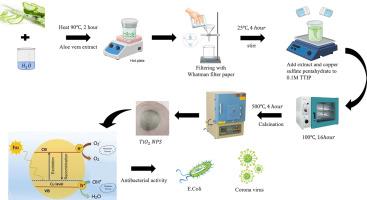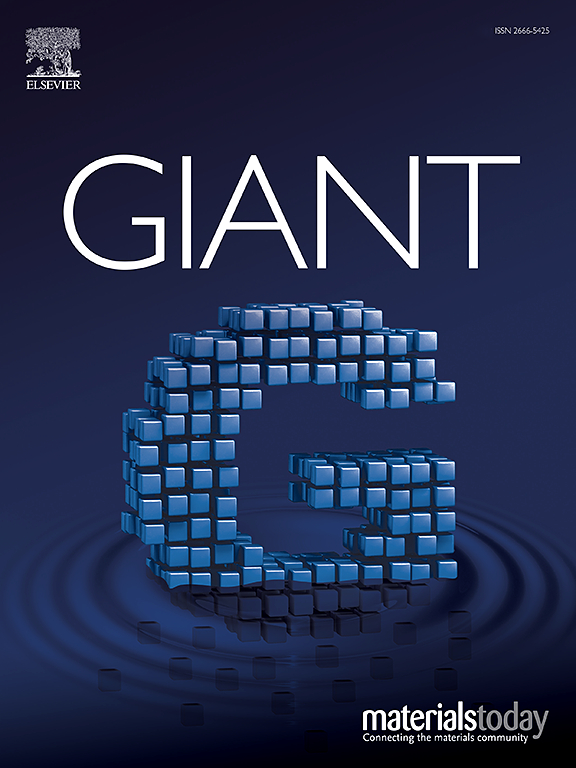芦荟提取物生物合成cu掺杂TiO2纳米颗粒净化消毒空气
IF 4.9
1区 化学
Q2 CHEMISTRY, MULTIDISCIPLINARY
引用次数: 0
摘要
利用植物提取物合成纳米颗粒因其简单、环保和成本效益而受到广泛关注。本研究以芦荟提取物为原料合成二氧化钛纳米粒子。此外,还研究了其与铜的掺杂,以降低电子/空穴对复合速率,提高二氧化钛的光催化活性。采用x射线衍射(XRD)、漫反射光谱(DRS)、透射电子显微镜(TEM)和场发射扫描电子显微镜(FE-SEM)对生物合成的纳米二氧化钛进行了表征。XRD报告了Scherrer法和Williamson-Hall法形成的尺寸分别为4-7 nm和5-27 nm的晶体。FE-SEM和TEM分析表明,颗粒呈球形。光谱结果表明,铜离子的加入使带隙能量从3.10 eV降低到2.89 eV。结果表明,在光照条件下,将掺杂剂浓度从1%提高到3%,细菌去除率从93%提高到96%,颗粒物去除率从91%提高到94%。因此,用芦荟提取物生物合成的Cu-TiO2纳米颗粒具有更高的光催化和抗菌活性,可用于空气净化。本文章由计算机程序翻译,如有差异,请以英文原文为准。

Air purification and disinfection by biosynthesized Cu-doped TiO2 nanoparticles with Aloe vera extract
The use of plant extracts for synthesizing nanoparticles has garnered significant attention due to their simplicity, environmental friendliness, and cost-effectiveness. This study synthesized titanium dioxide (titania, TiO2) nanoparticles using Aloe vera extract. Its doping with copper was also investigated to reduce the electron/hole pair recombination rate and improve the photocatalytic activity of titania. Biosynthesized titania nanoparticles were characterized by X-ray diffraction (XRD), Diffuse reflectance spectroscopy (DRS), transmission electron microscopy (TEM), and field emission scanning electron microscopy (FE-SEM). XRD reported the formation of crystals with sizes of 4–7 nm by the Scherrer method and 5–27 nm by the Williamson-Hall method. FE-SEM and TEM analysis showed the formation of spherical particles. Spectroscopic results showed that the addition of the copper ion reduced the band gap energy from 3.10 eV to 2.89 eV. It was observed that, under light, increasing the dopant concentration from 1 % to 3 % resulted in an increase in the bacterial removal rate from 93 % to 96 % and the particulate matter removal rate from 91 % to 94 %. Therefore, Cu-TiO2 nanoparticles biosynthesized with Aloe vera extract exhibited increased photocatalytic and antibacterial activity, which can be utilized for air purification.
求助全文
通过发布文献求助,成功后即可免费获取论文全文。
去求助
来源期刊

GIANT
Multiple-
CiteScore
8.50
自引率
8.60%
发文量
46
审稿时长
42 days
期刊介绍:
Giant is an interdisciplinary title focusing on fundamental and applied macromolecular science spanning all chemistry, physics, biology, and materials aspects of the field in the broadest sense. Key areas covered include macromolecular chemistry, supramolecular assembly, multiscale and multifunctional materials, organic-inorganic hybrid materials, biophysics, biomimetics and surface science. Core topics range from developments in synthesis, characterisation and assembly towards creating uniformly sized precision macromolecules with tailored properties, to the design and assembly of nanostructured materials in multiple dimensions, and further to the study of smart or living designer materials with tuneable multiscale properties.
 求助内容:
求助内容: 应助结果提醒方式:
应助结果提醒方式:


